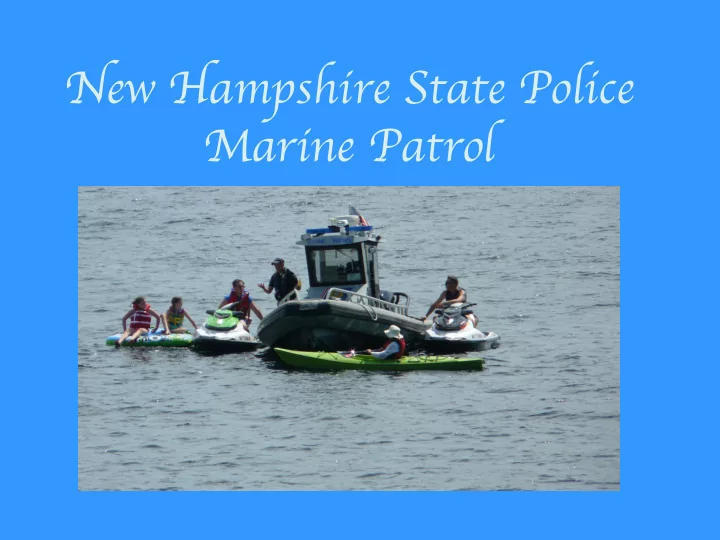

New Hampshire State Police Marine Patrol
MARINE PATROL STATUTORY REQUIREMENTS • Enforce NH Boating Laws and Rules • Provide Education to Recreational Boaters • Maintain Aids to Navigation • Powers on all Bodies of Water 10 Acres +
All vessels must be equipped with USCG-approved life jackets, also known as, personal flotation devices (PFDs) • Quantity and type of PFD required depends upon: – Length of vessel – Number of people onboard and/or being towed
5 TYPES of LIFE JACKETS • Type I: Offshore Life Jackets – For rough or remote waters where rescue may take awhile – Excellent for flotation -- will turn most unconscious persons face up in water – 2 sizes-Adult (over 90 lbs) and Child (up to 90 lbs) – All have reflectors and are reversible.
5 TYPES of LIFE JACKETS Type II: Near-Shore Vests –Good for calm waters and fast rescues –May lack capacity to turn unconscious wearers face up
5 TYPES of LIFE JACKETS • Type III: Flotation Aids –Good for calm waters and fast rescues –Will not turn a person face up –Some designed to inflate when you enter water
5 TYPES of LIFE JACKETS Type IV: Throwable Devices Cushions or ring buoys designed to be thrown to someone in trouble Not for long hours in rough waters, non-swimmers or the unconscious
5 TYPES of LIFE JACKETS • Type V: Special-Use Devices – Designed for specific activities such as kayaking or water skiing – Some designed to inflate when you enter water – To be legal, Type V PFDs must be worn and used in accordance with their label
PFD Requirements (cont.) • Vessels 16 ft. in length or longer (except canoes and kayaks) must also carry one USCG-approved Type IV throwable PFD onboard and immediately available. • Children 12 years of age and younger must wear a USCG-approved life jacket at all times while onboard any vessel unless vessel is completely enclosed by railings at least 3 ft. high and constructed such that a small child cannot fall through. It is strongly recommended that children of all ages wear life jackets
PFD Requirements (cont.) • Operators of ski craft must wear a USCG- approved life jacket • Each person being towed behind a vessel must wear a USCG-approved life jacket. • All persons using a Stand Up Paddleboard (SUP), must have a PFD available.
Paddleboards Too!!
Navigation Lights • Vessel operators must make sure that their vessels are equipped with proper navigation lights and use them during the following conditions: –When away from dock between sunset and sunrise –During periods of restricted visibility such as fog or heavy
Sound Producing Devices
Fire Extinguishers (cont.) Use this chart to determine the type and quantity of portable ext. required for a vessel: Length of Motorboat Without Fixed System With Fixed System* Less than 16 ft. 1 B-I None 16 ft. to less than 26 ft. 1 B-I None 26 ft. to less than 40 ft. 2 B-I or 1 B-II 1 B-I 40 ft. to less than 65 ft. 3 B-I or 1 B-II and 1 B-I 2 B-I or 1 B-II *refers to a permanently installed fire extinguisher system • Extinguishers should be placed in an accessible area – not near engine or in a compartment. • The vessel operator should be familiar with the condition and use of the extinguisher.
• White with Black Top If heading west or east, go north at this buoy. If heading north or south, go east at this buoy • White with Red Top If heading west or east, go south at this buoy. If heading north or south, go west at this buoy
Vessels operating on New Hampshire waters must observe these rules when encountering spar buoys: • All Black Used to mark one side of a well defined channel. Go between it and its companion “all red” spar buoy • All Red Used to mark one side of a well defined channel. Go between it and its companion “all black” spar buoy
Headway speed: 6 mph or the slowest speed that a boat can be operated and maintain steerage way.
Water skiing: a person being towed behind a moving motorboat on skis or on aquatic equipment designed for towing an aquaplane or any other device, including bare feet of a person, but excluding a person being towed in another boat or motorboat.
•No more than 2 persons may be towed at the same time on skis. One observer is required. •Observers must be 13 years or older (not including the operator). •It is a violation to ski between sunset and sunrise. •Anyone being towed on water skis must be wearing a PFD unless they have a special permit.
When towing water skiers, another person must be present who is physically able to assist and observe. •When towing tubes…2 persons being towed requires 1 observer. 3-6 persons being towed requires 2 observers. 6 is the maximum that can be towed.
VI. All vessels shall maintain headway speed when within 150 feet from: - Rafts, floats, swimmers - Permitted swimming areas - Shore - Docks - Mooring fields - Other vessels
WAKE SURFING
No person 16 yrs. or older shall operate a vessel with an engine in excess of 25 Hp without a valid certificate of boating safety education
AQUATIC INVASIVES
Boating Accident Investigations
Nice Parking!
Front View
Recommend
More recommend